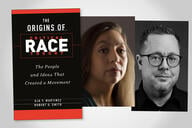You have /5 articles left.
Sign up for a free account or log in.
Talking Art: The Culture of Practice and the Practice of Culture in M.F.A. Education (University of Chicago Press) is a critical look at M.F.A. programs in visual arts, suggesting that they focus too much on theory and not enough on beauty and art.
The author is Gary Alan Fine, a professor of sociology at Northwestern University. He discussed his observations and conclusions via email.
Q: Please describe the M.F.A. programs you observed, saying what is possible about the institutions and the type of M.F.A. students you observed. Why did you focus on visual arts students?
A: For my ethnographic and observational research, I decided to focus on three schools offering M.F.A. degrees in the visual arts in the Chicago area. Each of these was a small university-based program with 10 to 30 students enrolled at any given time. I thought that it was important to examine how visual art has become an academic discipline and to understand how emerging artists navigate a university system that emphasizes theory and research, rather than simply craftsmanship and technique. This has been a striking change over the past half century, at which time arts were not part of graduate training.
At the outset of the project, I had intended to compare M.F.A. students in visual arts with those in creative writing programs, but it soon became clear that the pedagogical structures were very different, and that the visual arts programs were more open to observation in their critiques, and, as a result, I decided to focus on one artistic domain. However, it is my hope in the future to examine how diverse forms of cultural production are incorporated into the university system, including gastronomy, theater, dance, couture and poetry. Cultural industries once stood outside the academy; today they have been welcomed in.
Q: You write critically of a shift away from beauty in these programs. What role do you think beauty should play?
A: I have avoided a judgment that the current skepticism of beauty as a defining feature of the art world is necessarily harmful. I began my product lusting after beauty, but I found myself [thinking about] education. Giving priority to beauty is the stance of writers such as Dave Hickey or Tom Wolfe. In contrast, my point is that it is often the case that external audiences search for beauty -- for the emotional rewards of aesthetic pleasure.
The movement away from the “gorgeous” as the defining feature of visual art has been now been embraced by many critics and some collectors, not only by academics, and it must be admitted that not all art produced outside ivory towers has been lovely, now or in centuries past. Still, the questioning of beauty as a central criterion signals a replacement by personal or political messages. This is a belief that art is a form of philosophy, of theory and of social engagement. We see this turn in the various forms of relational aesthetics, performance art, conceptual art and other important artistic forms. Beauty draws in a wider public, but an academic discipline, as art is becoming, does not necessarily focus on that larger social world as its singular audience.
Q: Why do you feel theory takes on too large a role in these programs?
A: I step away from the assumption that theory plays too large a role in graduate arts education. However, by playing a central role, it justifies art as being based on the expression and presentation of ideas in form. I quote the great artist Ben Shahn as remarking that no one should want to hear what an artist has to say. The message is paint on canvas. This view -- that art speaks for itself -- was common 50 years ago but has lost power today.
The artist was once a sphinx but is now a chatterbox. Such a stance privileges the articulate, highly educated artist and marginalizes those with technical skills or aesthetic vision but without literary ability. In high schools many students who choose art classes were precisely those who did not feel comfortable in more “academic,” classroom pursuits. Now, as M.F.A. students, they are forced to engage in those very activities that they had once avoided. For some art students without intellectual backgrounds, this can be a challenge and a point of frustration, as I describe. The silent artist is often the ignored artist, just as is true for the artist who doesn’t wish to socialize except on her canvas.
Q: From your observations, do you think the students are being well prepared to become artists?
A: Students who receive their M.F.A. degrees in university-based programs are well prepared in the sense that they belong to a community that truly cares about their practice and that provides them with time and support to produce “work.” They have colleagues and they gain mentors. This works well for some, particularly those who have the social skills to learn from others. However, as I point out, these programs rarely teach techniques of art making.
One does not learn how to carve or how to lay paint on canvas. The training that does occur requires individual motivation. In the course of my research, I learned a lot about criticism, critique and theory, but very little about how to make art. Thinking back to my days in high school, I would now be a more sophisticated artist but not a more proficient painter. In other words, I learned how to “be” an artist but much less about how to “make” art as a matter of craft.
In addition, students are not trained in the business of art or in the practical matter of establishing a career. Talking about earning a living from one’s practice is considered “dirty” and, in many programs, there is a sharp divide between money and creativity. When these young men and women graduate, there is rarely a next step. They are on their own. They must find employment in the penumbra of the art world. Perhaps they become gallery assistants, helpers of established artists, baristas or, in one case, an underwear model, a brief career. In most professions, career preparation is essential, and this absence explains why many artists change their goals when they determine that they are unlikely to have a secure life.
One should also remember that when artists enter an M.F.A. program, they are already artists, sometimes with emerging careers, and so the task of the art program is to help clarify and refine their techniques. Instructors are committed to their students (at least most are), and they can and do serve as role models and guides to valuable networks.
Q: If you could redesign M.F.A. programs, what are two changes you would make?
A: In Talking Art I discuss the challenges of organizing a productive critique. While these student evaluations by faculty, art world guests and fellow students are often productive in a challenging way, I have watched them become hostile sites by playing out aggression. In this sense, M.F.A. critiques are not so different from the Little League baseball games in which parents, but memorably, lose control.
As a result, I believe that art programs should do several things. First, proclaim a culture of respect in student evaluations, becoming part of the program vision. This should involve respect for the diversity of race, ethnicity, religion and politics. Second, each student should select a “buddy” who can redirect the conversation if it becomes too personal. Third, each program should appoint a faculty member for each set of evaluations whose responsibility is to ensure that even if the critiques are critical -- as they may need to be -- they are never personal. Assigning this potentially powerful role -- a critique monitor -- to a senior faculty member is crucial. These changes would avoid having to mop up the blood -- or the tears -- on the floor.
The second change is to recognize, as some programs do, that art is a career, and that the possibilities for postschool practice should be discussed. This does not mean that every artist must sell herself or her work, but that students should learn about the diversity of artistic lives. While there will be an oversupply of artists, and not all will be able to live off their practices, the options and opportunities should be presented.




